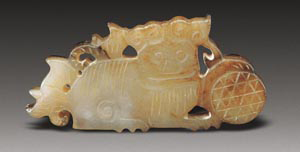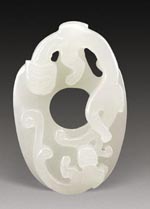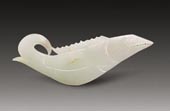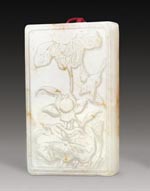Jade and Jade Carving
Chinese began to know and use jade in the early Neolithic Age according to archeologists and archeological findings.  Many jade wares dating back to 4,000 to 6,000 years ago have been excavated in different places. It was not only used for decorative purpose but also others. Until the Shang and Zhou dynasties, jade wares had been developed into tools, weapons, daily utensils, accessories and ritual utensils. As commodity exchange boomed, jade was bestowed with currency function. For thousands of years till now, jade was and is a symbol of love and virtue as well as a status symbol.
Many jade wares dating back to 4,000 to 6,000 years ago have been excavated in different places. It was not only used for decorative purpose but also others. Until the Shang and Zhou dynasties, jade wares had been developed into tools, weapons, daily utensils, accessories and ritual utensils. As commodity exchange boomed, jade was bestowed with currency function. For thousands of years till now, jade was and is a symbol of love and virtue as well as a status symbol.
 In the Zhou dynasty, jade use was first regulated in Zhouli (Rites of the Zhou), which was the constitution of the Zhou dynasty concerning with politics, economy, military, diplomacy and law. With other two classics named Yili (Rites) and Liji (Book of Rites) later, it strictly stipulated national rites and etiquettes and directing philosophy. Only in Zhouli, Rites of the Zhou, there were dozens of articles concerning with jade use and function under different occasions such as politics, sacrifice, alliance, and military activities, etc. According to the three classics, special ministry should be set up to manage jade use. It was stipulated that six jade ritual items should be made to offer sacrifice to heaven, the earth, the east, the south, the west and the north. There were also strict regulations on six jade tablets used by emperors, dukes, marquises, earls, viscounts and barons respectively. Jade ware can be divided into following categories - ritual utensil, funeral utensil, accessory, currency, weapon, diplomatic gift, musical instrument and food according to the functions listed in the three classics. Simple carving, careful handling and not mixing private and public ritual vessel were basic rules to follow in jade use.
In the Zhou dynasty, jade use was first regulated in Zhouli (Rites of the Zhou), which was the constitution of the Zhou dynasty concerning with politics, economy, military, diplomacy and law. With other two classics named Yili (Rites) and Liji (Book of Rites) later, it strictly stipulated national rites and etiquettes and directing philosophy. Only in Zhouli, Rites of the Zhou, there were dozens of articles concerning with jade use and function under different occasions such as politics, sacrifice, alliance, and military activities, etc. According to the three classics, special ministry should be set up to manage jade use. It was stipulated that six jade ritual items should be made to offer sacrifice to heaven, the earth, the east, the south, the west and the north. There were also strict regulations on six jade tablets used by emperors, dukes, marquises, earls, viscounts and barons respectively. Jade ware can be divided into following categories - ritual utensil, funeral utensil, accessory, currency, weapon, diplomatic gift, musical instrument and food according to the functions listed in the three classics. Simple carving, careful handling and not mixing private and public ritual vessel were basic rules to follow in jade use.
 Ancient Chinese believed jade the essence of Heaven and the Earth, so they carved jade into birds and beasts and worshiped as totems. Then witchcraft soon applied jade as percussion instrument since it sounded pleasing to the ear and traveled far. After people knew musical scales, jade became musical instrument. The ancients seemingly tended to associate jade with heroes who made great contributions, for Emperor Yan, God of Farming and Emperor Huang who united China first.
Ancient Chinese believed jade the essence of Heaven and the Earth, so they carved jade into birds and beasts and worshiped as totems. Then witchcraft soon applied jade as percussion instrument since it sounded pleasing to the ear and traveled far. After people knew musical scales, jade became musical instrument. The ancients seemingly tended to associate jade with heroes who made great contributions, for Emperor Yan, God of Farming and Emperor Huang who united China first.
Jade was also the symbol of power. In the ancient time, only aristocrats could own jade wares. The imperial seal of the Qin dynasty, the first feudal society in China, was made of jade. The seal was later hunt by seigneurs to prove they were the real Heavenly Sons.
Furthermore, more noble attributes were given to jade, making it a standard of morality. Confucius even concluded jade had 11 virtues, namely benevolence, fidelity, polite etiquette, wisdom and sincerity, etc. Hence, it was not only a decoration but also a symbol of ethics and norms. People then threw themselves into the vogue to ware jade accessories. It was said that a gentleman would never leave his jade ornaments.
Jade was believed capable of standing for Heaven, the Earth, the east, the west, the south and the north and emperors.  It can be messenger between Heaven and mankind. In the ancient times, Yu, Chinese character meaning jade, was the same with Wang (king). The three horizontal strokes stringed by a central vertical stroke represent Heaven, the Earth and mankind respectively. Hence yu, is always used in Chinese to call something precious and jade had always been treasured in China as the royal gemstone.
It can be messenger between Heaven and mankind. In the ancient times, Yu, Chinese character meaning jade, was the same with Wang (king). The three horizontal strokes stringed by a central vertical stroke represent Heaven, the Earth and mankind respectively. Hence yu, is always used in Chinese to call something precious and jade had always been treasured in China as the royal gemstone.
Chinese people believed jade had supernatural power. Using jade wares and jade ornaments could resist invasion of evil influence and avoid evil apparitions and secure safety and auspiciousness.
 Sounding strange, some people believed, however, that jade was edible and could keep one physically immortal. Most of them are Taoists.
Sounding strange, some people believed, however, that jade was edible and could keep one physically immortal. Most of them are Taoists.
These precious stones played significant role in the development and spread of religions in China. Since belief the ancients bestowed with jade is coincident with religion in many aspects, jade serves religion. In the Buddhism, the PureLand is composed of gold, silver, agate, coral, amber and gray jade. Thus Chinese Buddhism emphasizes collecting and using various precious stones. In FamenTemple in Shaanxi province, near Xi'an, among the four Buddhist Relics discovered, one was placed in tailor made jade coffin. The Buddhas and Buddhism musical instruments in the PotalaPalace and Ta'er Lamasery are mostly decorated with lazuli, turquoise, agate, gray jade and white jade. Until the Tang dynasty, Buddhism reached its peak, and jade carvings concerning with Buddhism, such as Amitabha, Kwan-yin, prayer beads, avalanched as amulets to protect people from disease and evil and agents to carry their emotion, expectation and belief to Buddha. Alike, in Taoism, jade has such functions too.

